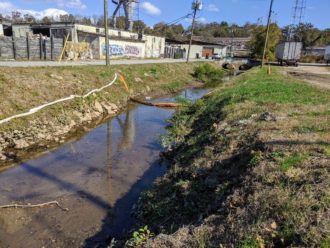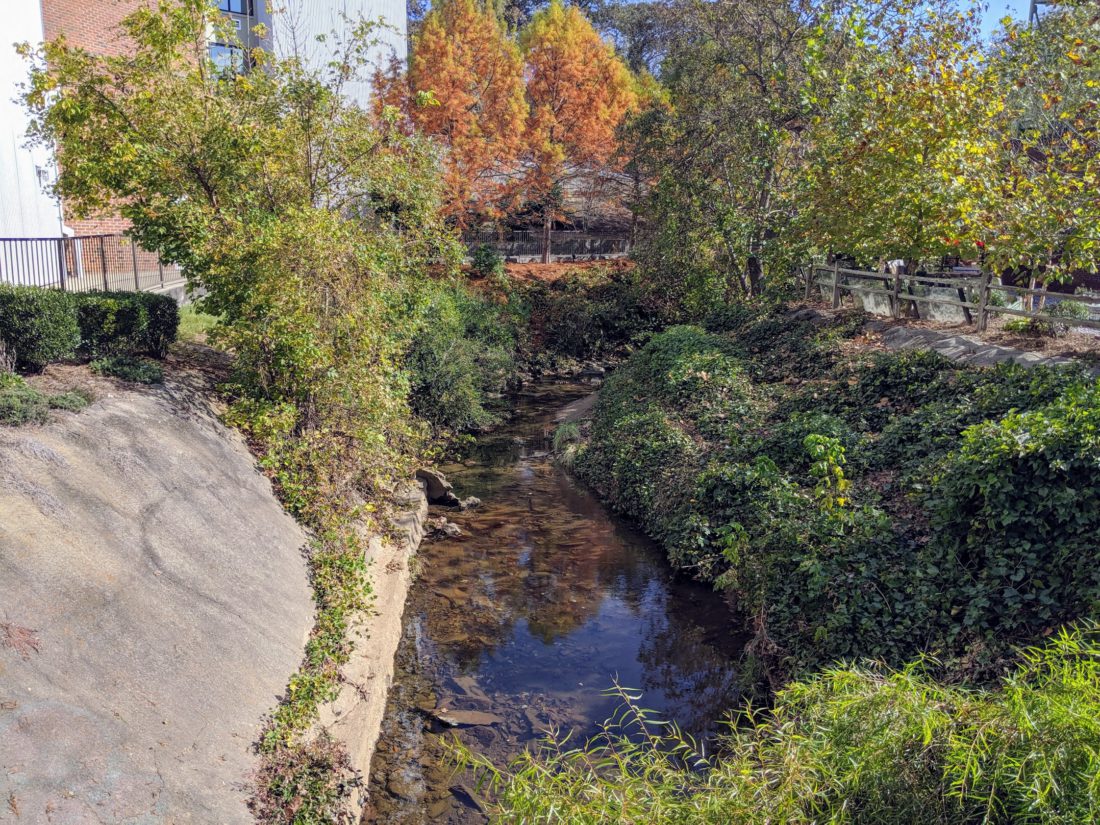Out of view of the paddleboards and kayaks that meander with the lazy flow of the French Broad River, an orange tube skims oil from a creek’s surface. The tube is a last line of defense preventing oil from flowing directly into the river. The creek is Town Branch, a waterway long believed to be the most polluted stream in Western North Carolina.
“Many people still call it Nasty Branch,” says Renee Fortner, watershed resources manager for the Asheville-based nonprofit RiverLink. For her, Town Branch is not just a matter of a single ailing creek. Instead, it’s part of a system in dire need of repair.
If the health of the French Broad is a concern, Fortner argues, then the health of its tributaries — including the River Arts District Watershed that contains Town Branch — cannot be ignored.
The stream, along with Bacoate Branch and an unnamed tributary, flows from Asheville through the RAD and into the French Broad. Along the journey downstream, these waterways pick up pollutants, sediment, bacteria and chemical runoff from the city.
Fortner notes that stream cleanups are a regular remediation activity for RiverLink. “To try and clean the stream, we work with volunteers to remove the trash, build riparian habitat and perform invasive species removal,” she says. But while these efforts are good for treating the symptoms of stream impairment, she admits, they leave the root causes of pollution untouched.
The RAD Watershed Restoration Plan is RiverLink’s response to this problem. Funded by a $78,000 grant from the N.C. Clean Water Management Fund and a $28,000 grant from the Pigeon River Fund, the yearlong assessment of the watershed’s health will include water quality monitoring, identification of pollution sources and suggestions for infrastructure changes. The goal is to provide long-term, meaningful protection for Asheville’s ailing waterways.
What’s in the water?

Hartwell Carson, MountainTrue’s French Broad Riverkeeper, identifies two common types of pollution as playing large roles in stream impairment. “Sediment and bacteria are the two biggest pollutants,” he explains. “Sediment comes from construction sites, agriculture and streambank erosion. Bacteria come from the sewer, septic tanks and animal agriculture.”
Among Carson’s jobs is taking samples to measure contamination levels in Asheville’s water. He has collected several months of data specifically from Town Branch, which shows that pollutants are a consistent issue in the stream. Dramatic spikes in pollutants take place after rain events, he says, due to increased water runoff from streets and parking lots.
Carson stresses that high E. coli levels are a pressing concern. Sewer leaks are a likely culprit but are not the only potential source of bacterial contamination. Garbage or animal excrement from dog parks, he says, could also be to blame.
An additional worry for Town Branch is an oil leak on railroad company Norfolk Southern’s property in the RAD. According to the N.C. Division of Water Resources, the leak apparently originates from a concrete box culvert that lies underneath the Norfolk Southern Railway and above Town Branch. However, the state Division of Waste Management has also examined the site and failed to arrive at the same conclusion.
While DWR says it is impossible to know how much oil has been leaked so far, the division characterizes the leak as “slow and intermittent” in comments provided to Xpress. The age of the leak is unknown as well, but samples from the site are highly degraded, suggesting the oil is quite old.
DWR confirms that Norfolk Southern is responsible for inspecting and replacing the oil-absorbent boom that scrubs petroleum from the water’s surface downstream of the leak twice a month. In addition, DWR inspects the site monthly and takes oil samples upstream from the boom.
“Nasty Branch”
The RAD Watershed Restoration Plan is not the first time the health of Asheville’s streams has been called into question. A Citizen Times article dated July 18, 1971, carried the headline, “Asheville’s Nasty Branch Should be Wiped off the Map.” In it, the paper’s editorial board described the creek otherwise known as Town Branch as an “ugly scar that slashes across the city’s middle.”
Asheville buried most of Nasty Branch during one of the largest urban renewal projects of the 1970s. During this time, the predominantly African American neighborhoods of East End and Southside were systematically dismantled. As the landscape of the city was being transformed, Nasty Branch was piped underground.
“The city really focused on [Nasty Branch] as a polluted place, taking the stance that it needed to be covered up,” says Sarah Judson, professor of history at UNC Asheville and author of several essays on Asheville’s urban renewal period. She explains that residents of the East End neighborhood found Nasty Branch to be part of their neighborhood’s identity, whether it was polluted or not.
“I always sat in my backyard and tried to figure out why they called it Nasty Branch because other than when it rained, the water was pretty and clear and I would just play in it and fish in it and just make a whole day of sitting there and being creative,” recalls Johnnie Grant, founder of The Urban News and a former resident of the East End/Valley street neighborhood, as quoted in Judson’s 2014 essay, “I Am a Nasty Branch Kid.”
Asheville residents must reclaim the identities of the waterways for themselves, Fortner says, or else they will remain untreated. Bacoate Branch, one of the three streams in the RAD Watershed Restoration Plan, was an unnamed tributary until RiverLink began a campaign through which residents named the stream after the late Osie W. Bacoate, a teacher, civil rights activist and resident of the West Asheville-Clingman Avenue neighborhood.
Wetlands and watersheds
To ensure the health of urban waterways in Asheville, the RAD Watershed Restoration Plan’s first priority is identifying distinct point sources of pollution. Marshall Taylor, project manager for Asheville-based environmental consultancy Blue Earth, which was hired by RiverLink to lead the project, says those problems could stem from a wide range of activities both present and left over from the city’s more industrial past.
Prioritizing pollution source treatment can be difficult, Taylor continues, because some sources contribute heavily to stream impairment while others do not. Pollutants from these places can enter Town Branch through stormwater drains, he adds, so each case must be treated individually.
Some problems are easy to solve. Carson says one source of Town Branch pollution came from the city of Asheville washing its street sweepers near a storm drain, an activity that could be moved to a better location. Others are more difficult: The source of a pipe Carson found emitting a “murky, brown liquid” into the steam that tests high for E. coli remains unknown.
The second of the plan’s strategies is finding the best locations to build green infrastructure such as wetlands along the stream banks. Wetlands, which catch surface water that would normally overwhelm the banks, can help protect streams against the inflow of pollutants, sediment and excess water. This approach also provides free water purification services for the community.
“There is going to be no silver bullet,” Taylor says about taking care of Town Branch and other parts of the RAD Watershed. “It is going to take a large number of actions working together to achieve this goal.”



Before you comment
The comments section is here to provide a platform for civil dialogue on the issues we face together as a local community. Xpress is committed to offering this platform for all voices, but when the tone of the discussion gets nasty or strays off topic, we believe many people choose not to participate. Xpress editors are determined to moderate comments to ensure a constructive interchange is maintained. All comments judged not to be in keeping with the spirit of civil discourse will be removed and repeat violators will be banned. See here for our terms of service. Thank you for being part of this effort to promote respectful discussion.